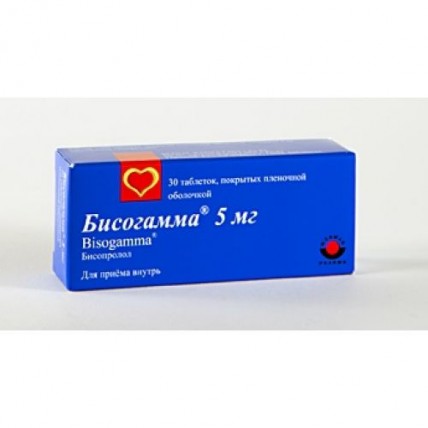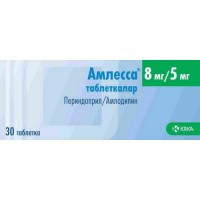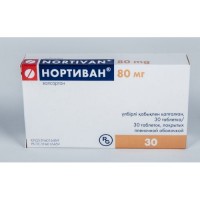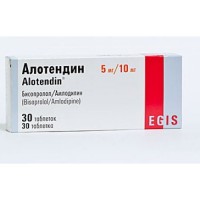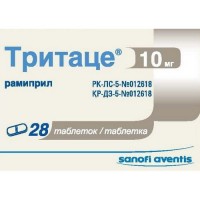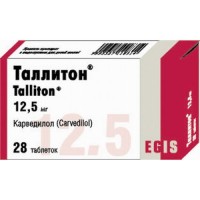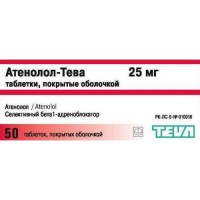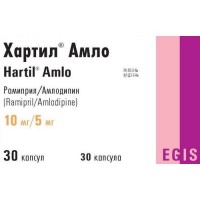Bisogamma 30s 5 mg film-coated tablets
- $4.80
Sku:
1b7bbc3648c5
Ingredient:
Bisoprolol
Pharmacological action:
Selection beta1-adrenoblocker without own SMA, has hypotensive, antiarrhytmic and anti-anginal effect. Blocking heart beta1-adrenoceptors in low doses, reduces stimulated catecholamines formation of tsAMF from ATP, reduces intracellular current of Ca2+, renders negative hrono-, dromo-, batmo- and inotropic action (urezhat ChSS, the conductivity and excitability oppresses, reduces contractility of a myocardium). At increase in a dose has beta2-adrenoceptor blocking effect. OPSS at the beginning of use of beta blockers, in the first 24 h, increases (as a result of reciprocal increase of activity of alpha adrenoceptors and elimination of stimulation of beta2-adrenoceptors) which in 1-3 days returns to initial, and at long appointment decreases. The hypotensive effect is connected with reduction of the IOC, sympathetic stimulation of peripheral vessels, decrease of the activity system renin-angiotenzinovoy (has bigger value for patients with initial hypersecretion of renin), recovery of sensitivity of baroreceptors of an aortic arch (there is no strengthening of their activity in response to decrease in the ABP) and influence on central nervous system. In arterial hypertension the effect occurs in 2-5 days, stable action - in 1-2 months. The anti-anginal effect is caused by reduction of need of a myocardium for oxygen as a result of an urezheniye of ChSS and decrease in contractility, lengthening of a diastole, improvement of perfusion of a myocardium. Due to increase in end diastolic pressure in a left ventricle and increases in stretching of muscle fibers of ventricles can increase oxygen requirement, especially at patients with HSN. The antiarrhytmic effect is caused by elimination of aritmogenny factors (tachycardias, superactivity of sympathetic nervous system, the increased maintenance of tsAMF, arterial hypertension), reduction of speed of spontaneous excitement of sinus and ectopic pacemakers and delay of AV of carrying out (mainly in antegrade and to a lesser extent in retrograde the directions through an AV node) and on additional ways. Unlike non-selective beta blockers when assigning in average therapeutic doses has less significant impact on the bodies containing beta2-adrenoceptors (pancreas, skeletal muscles, smooth muscles of peripheral arteries, bronchial tubes and a uterus) and on carbohydrate metabolism, does not cause Na delay + in an organism, the expressiveness of atherogenous action does not differ from effect of propranolol. At use in high doses renders the blocking effect on both subtypes of beta adrenoceptors. Indications:
Arterial hypertension, ischemic heart disease, angina of exertion, myocardial infarction (secondary prevention). Disturbances of a rhythm - sinus tachycardia, supraventricular and ventricular premature ventricular contraction, arrhythmias against the background of a prolapse of the mitral valve, a thyrotoxicosis. Contraindications:
Hypersensitivity, sharp SN or dekompensirovanny HSN, cardiogenic shock, AV blockade of the II-III article, SA blockade, SSSU, bradycardia about ChSS less than 40/mines, Printsmetal's stenocardia, a cardiomegaly (without signs of SN), arterial hypotension (systolic arterial blood pressure less than 90 mm Hg., especially in a myocardial infarction), the lactation period, a concomitant use of Mao.C inhibitors care. Allergic reactions in the anamnesis, HOBL (bronchial asthma, emphysema), the diabetes, a metabolic acidosis, HSN obliterating diseases of peripheral vessels (the 'alternating' lameness, Reynaud's syndrome), a pheochromocytoma, a liver failure, HPN, a myasthenia, a thyrotoxicosis, a depression (including in the anamnesis), psoriasis, pregnancy, advanced age, children's age (the efficiency and safety are not defined).Side effects:
From nervous system: increased fatigue, weakness, dizziness, a headache, drowsiness or insomnia, 'dreadful' dreams, a depression, concern, confusion of consciousness or short-term loss of memory, a hallucination, an asthenia, a myasthenia, paresthesias in extremities (at patients with the 'alternating' lameness and Reynaud's syndrome), a tremor. From sense bodys: disorder of vision, reduction of secretion of plaintive liquid, dryness and morbidity of eyes, conjunctivitis. From CCC: sinus bradycardia, heartbeat, disturbance of conductivity of a myocardium, AV blockade (up ment of a total cross block and cardiac arrest), arrhythmias, easing of contractility of a myocardium, development (aggravation) of HSN, decrease in the ABP, orthostatic hypotension, manifestation of a vasomotor spasm (strengthening of disturbance of peripheric circulation, a cold snap of the lower extremities, Reynaud's syndrome), a stethalgia. From digestive system: dryness of a mucous membrane of an oral cavity, nausea, vomiting, abdominal pain, constipations or diarrhea, abnormal liver functions (dark urine, yellowness of scleras or skin, cholestasia), changes of taste. From a respiratory system: congestion of a nose, difficulty of breath when assigning in high doses (loss of selectivity) and/or at predisposed patients - laringo- and a bronchospasm. From an endocrine system: a hyperglycemia (at patients with non-insulin-dependent diabetes mellitus), a hypoglycemia (at the patients receiving insulin), a hypothyroid state. Allergic reactions: itching, rash, urticaria. From integuments: sweating strengthening, dermahemia, dieback, psoriazopodobny skin reactions, aggravation of symptoms of psoriasis. Laboratory indicators: thrombocytopenia (unusual bleedings and hemorrhages), agranulocytosis, leukopenia, change of activity of enzymes, bilirubin level. Influence on a fruit: pre-natal growth inhibition, hypoglycemia, bradycardia. Other: dorsodynia, arthralgia, weakening of a libido, decrease in potency, syndrome of 'cancellation' (strengthening of attacks of stenocardia, increase in the ABP). Overdose. Symptoms: arrhythmia, ventricular premature ventricular contraction, profound bradycardia, AV blockade, decrease in the ABP, HSN, cyanosis of nails of fingers or palms, breath difficulty, bronchospasm, dizziness, unconscious states, spasms. Treatment: gastric lavage and purpose of the adsorbing HP, symptomatic therapy: at the developed AV to blockade - in/in introduction of 1-2 mg of atropine, epinephrine or statement of a temporary pacemaker, in ventricular premature ventricular contraction - lidocaine (the drugs Ia of a class are not used), at decrease in the ABP - the patient has to be in position of Trendelenburg if there are no symptoms of a fluid lungs, - in/in plasma substituting solutions, at inefficiency - administration of epinephrine, a dopamine, Dobutaminum (for maintenance of chronotropic and inotropic action and elimination of the significant decrease in the ABP), at SN - cardiac glycosides, diuretics, a glucagon, in spasms - in/in diazepam, at a bronchospasm - beta2-adrenostimulyator is inhalation. Route of administration and doses:
Inside, in the morning on an empty stomach, without chewing, 2.5-5 mg once. If necessary the dose is increased to 10 mg of 1 times a day. The maximum dose for adults - 20 mg/days. Patients with a renal failure at KK have less than 20 ml/min. or with the profound abnormal liver functions a daily dose - 10 mg. Special instructions:
Control of the patients accepting bisoprolol has to include observation of ChSS and the ABP (in an initiation of treatment - daily, then 1 time in 3-4 months), the ECG, blood glucose content at patients with diabetes (1 time in 4-5 months). At elderly patients it is recommended to monitor function of kidneys (1 time in 4-5 months). It is necessary to train the patient in a technique of calculation of ChSS and to instruct about need of medical consultation at ChSS less than 50/min. Before an initiation of treatment it is recommended to conduct a research of function of external respiration at patients with the burdened bronchopulmonary anamnesis. Approximately at 20% of patients with stenocardia beta blockers are inefficient. Basic reasons - heavy coronary atherosclerosis with a low threshold of ischemia (ChSS less than 100/mines) and the raised KDO LZh breaking a subendocardial blood stream. At 'smokers' the efficiency of beta blockers is lower. The patients using contact lenses have to consider that against the background of treatment the reduction of products of plaintive liquid is possible. When using the patients with a pheochromocytoma have a risk of developing paradoxical arterial hypertension (if it is previously not reached effective alpha adrenoblokada). In a thyrotoxicosis bisoprolol can disguise certain clinical signs of a thyrotoxicosis (for example tachycardia). Sharp cancellation at patients with a thyrotoxicosis is contraindicated as it is capable to strengthen symptomatology. In diabetes can disguise the tachycardia caused by a hypoglycemia. Unlike non-selective beta blockers practically does not strengthen the hypoglycemia caused by insulin and does not delay recovery of the contents of glucose in blood to normal level. At a concomitant use of a clonidine its reception can be stopped only in several days after cancellation of a bisoprolol. Strengthening of expressiveness of reaction of hypersensitivity and lack of effect of usual doses of epinephrine against the background of the burdened allergological anamnesis is possible. In case of need performing planned surgical treatment carry out drug withdrawal for 48 h prior to the beginning of the general anesthesia. If the patient took the drug before operation, it should pick up HP for the general anesthesia with the minimum negative inotropic effect. Reciprocal activation of n.vagus can be eliminated in/in administration of atropine (1-2 mg). The HP reducing stocks of catecholamines (for example reserpine), can strengthen effect of beta blockers therefore the patients accepting such combinations of HP have to be under constant observation of the doctor regarding detection of arterial hypotension or bradycardia. Patients with bronkhospastichesky diseases can appoint cardioselective adrenoblockers in case of intolerance and/or inefficiency of other hypotensive HP, but at the same time it is necessary to watch a dosage strictly. The overdose is dangerous by development of a bronchospasm. In case of emergence in patients of advanced age of the accruing bradycardia (less than 50/mines), arterial hypotension (systolic arterial blood pressure is lower than 100 mm Hg.), AV of blockade, a bronchospasm, ventricular arrhythmias, heavy abnormal liver functions and kidneys it is necessary to reduce a dose or to stop treatment. It is recommended to stop therapy at development of the depression caused by intake of beta blockers. It is impossible to interrupt sharply treatment because of danger of development of heavy arrhythmias and a myocardial infarction. Cancellation is carried out gradually, reducing a dose during 2 weeks and more (lower a dose by 25% in 3-4 days). Use at pregnancy and a lactation is possible if the advantage for mother exceeds risk of development of side effects at a fruit and the child. It is necessary to cancel before a research of content in blood and urine of catecholamines, a normetanefrin and vanililmindalny acid, credits of antinuclear antibodies. During treatment it is necessary to be careful during the driving of motor transport and occupation other potentially dangerous types of activity demanding the increased concentration of attention and speed of psychomotor reactions. Interaction:
The allergens used for an immunotherapy or extracts of allergens for skin tests increase risk of emergence of heavy system allergic reactions or an anaphylaxis at the patients receiving bisoprolol. Iodinated X-ray contrast HP for in/in introductions increase risk of development of anaphylactic reactions. Phenytoinum at in in introduction, HP for inhalation general anesthesia (derivatives of hydrocarbons) is raised by expressiveness of cardiodepressive action and probability of decrease in the ABP. Changes efficiency of insulin and oral hypoglycemic HP, masks symptoms of the developing hypoglycemia (tachycardia, increase in the ABP). Reduces clearance of lidocaine and xanthines (except Diphyllinum) and increases their concentration in plasma, especially at patients with initially increased clearance of theophylline under the influence of smoking. Hypotensive effect NPVP (Na delay + and blockade of synthesis of Pg kidneys) weaken, GKS and estrogen (Na+ delay). Cardiac glycosides, Methyldopum, reserpine and guanfatsin, BMKK (verapamil, diltiazem), Amiodaronum, etc. antiarrhytmic HP increase risk of development or aggravation of bradycardia, AV of blockade, cardiac arrest and SN. Nifedipine can lead to considerable decrease in the ABP. Diuretics, a clonidine, sympatholytics, gidralazin, etc. can lead hypotensive HP to excessive decrease in the ABP. Extends action of not depolarizing muscle relaxants and anticoagulating effect of coumarins. Rub - and tetracyclic antidepressants, antipsychotic HP (neuroleptics), ethanol, sedative and HP hypnotic drugs strengthen oppression of central nervous system. Simultaneous use with MAO inhibitors owing to considerable strengthening of hypotensive action is not recommended, having rummaged in treatment between intake of MAO inhibitors and a bisoprolola has to make not less than 14 days. Not hydrogenated alkaloids of an ergot increase risk of development of disturbances of peripheric circulation. Ergotamine increases risk of development of disturbance of peripheric circulation, Sulfasalazinum increases concentration of a bisoprolol in plasma, rifampicin shortens T1/2.
Selection beta1-adrenoblocker without own SMA, has hypotensive, antiarrhytmic and anti-anginal effect. Blocking heart beta1-adrenoceptors in low doses, reduces stimulated catecholamines formation of tsAMF from ATP, reduces intracellular current of Ca2+, renders negative hrono-, dromo-, batmo- and inotropic action (urezhat ChSS, the conductivity and excitability oppresses, reduces contractility of a myocardium). At increase in a dose has beta2-adrenoceptor blocking effect. OPSS at the beginning of use of beta blockers, in the first 24 h, increases (as a result of reciprocal increase of activity of alpha adrenoceptors and elimination of stimulation of beta2-adrenoceptors) which in 1-3 days returns to initial, and at long appointment decreases. The hypotensive effect is connected with reduction of the IOC, sympathetic stimulation of peripheral vessels, decrease of the activity system renin-angiotenzinovoy (has bigger value for patients with initial hypersecretion of renin), recovery of sensitivity of baroreceptors of an aortic arch (there is no strengthening of their activity in response to decrease in the ABP) and influence on central nervous system. In arterial hypertension the effect occurs in 2-5 days, stable action - in 1-2 months. The anti-anginal effect is caused by reduction of need of a myocardium for oxygen as a result of an urezheniye of ChSS and decrease in contractility, lengthening of a diastole, improvement of perfusion of a myocardium. Due to increase in end diastolic pressure in a left ventricle and increases in stretching of muscle fibers of ventricles can increase oxygen requirement, especially at patients with HSN. The antiarrhytmic effect is caused by elimination of aritmogenny factors (tachycardias, superactivity of sympathetic nervous system, the increased maintenance of tsAMF, arterial hypertension), reduction of speed of spontaneous excitement of sinus and ectopic pacemakers and delay of AV of carrying out (mainly in antegrade and to a lesser extent in retrograde the directions through an AV node) and on additional ways. Unlike non-selective beta blockers when assigning in average therapeutic doses has less significant impact on the bodies containing beta2-adrenoceptors (pancreas, skeletal muscles, smooth muscles of peripheral arteries, bronchial tubes and a uterus) and on carbohydrate metabolism, does not cause Na delay + in an organism, the expressiveness of atherogenous action does not differ from effect of propranolol. At use in high doses renders the blocking effect on both subtypes of beta adrenoceptors. Indications:
Arterial hypertension, ischemic heart disease, angina of exertion, myocardial infarction (secondary prevention). Disturbances of a rhythm - sinus tachycardia, supraventricular and ventricular premature ventricular contraction, arrhythmias against the background of a prolapse of the mitral valve, a thyrotoxicosis. Contraindications:
Hypersensitivity, sharp SN or dekompensirovanny HSN, cardiogenic shock, AV blockade of the II-III article, SA blockade, SSSU, bradycardia about ChSS less than 40/mines, Printsmetal's stenocardia, a cardiomegaly (without signs of SN), arterial hypotension (systolic arterial blood pressure less than 90 mm Hg., especially in a myocardial infarction), the lactation period, a concomitant use of Mao.C inhibitors care. Allergic reactions in the anamnesis, HOBL (bronchial asthma, emphysema), the diabetes, a metabolic acidosis, HSN obliterating diseases of peripheral vessels (the 'alternating' lameness, Reynaud's syndrome), a pheochromocytoma, a liver failure, HPN, a myasthenia, a thyrotoxicosis, a depression (including in the anamnesis), psoriasis, pregnancy, advanced age, children's age (the efficiency and safety are not defined).Side effects:
From nervous system: increased fatigue, weakness, dizziness, a headache, drowsiness or insomnia, 'dreadful' dreams, a depression, concern, confusion of consciousness or short-term loss of memory, a hallucination, an asthenia, a myasthenia, paresthesias in extremities (at patients with the 'alternating' lameness and Reynaud's syndrome), a tremor. From sense bodys: disorder of vision, reduction of secretion of plaintive liquid, dryness and morbidity of eyes, conjunctivitis. From CCC: sinus bradycardia, heartbeat, disturbance of conductivity of a myocardium, AV blockade (up ment of a total cross block and cardiac arrest), arrhythmias, easing of contractility of a myocardium, development (aggravation) of HSN, decrease in the ABP, orthostatic hypotension, manifestation of a vasomotor spasm (strengthening of disturbance of peripheric circulation, a cold snap of the lower extremities, Reynaud's syndrome), a stethalgia. From digestive system: dryness of a mucous membrane of an oral cavity, nausea, vomiting, abdominal pain, constipations or diarrhea, abnormal liver functions (dark urine, yellowness of scleras or skin, cholestasia), changes of taste. From a respiratory system: congestion of a nose, difficulty of breath when assigning in high doses (loss of selectivity) and/or at predisposed patients - laringo- and a bronchospasm. From an endocrine system: a hyperglycemia (at patients with non-insulin-dependent diabetes mellitus), a hypoglycemia (at the patients receiving insulin), a hypothyroid state. Allergic reactions: itching, rash, urticaria. From integuments: sweating strengthening, dermahemia, dieback, psoriazopodobny skin reactions, aggravation of symptoms of psoriasis. Laboratory indicators: thrombocytopenia (unusual bleedings and hemorrhages), agranulocytosis, leukopenia, change of activity of enzymes, bilirubin level. Influence on a fruit: pre-natal growth inhibition, hypoglycemia, bradycardia. Other: dorsodynia, arthralgia, weakening of a libido, decrease in potency, syndrome of 'cancellation' (strengthening of attacks of stenocardia, increase in the ABP). Overdose. Symptoms: arrhythmia, ventricular premature ventricular contraction, profound bradycardia, AV blockade, decrease in the ABP, HSN, cyanosis of nails of fingers or palms, breath difficulty, bronchospasm, dizziness, unconscious states, spasms. Treatment: gastric lavage and purpose of the adsorbing HP, symptomatic therapy: at the developed AV to blockade - in/in introduction of 1-2 mg of atropine, epinephrine or statement of a temporary pacemaker, in ventricular premature ventricular contraction - lidocaine (the drugs Ia of a class are not used), at decrease in the ABP - the patient has to be in position of Trendelenburg if there are no symptoms of a fluid lungs, - in/in plasma substituting solutions, at inefficiency - administration of epinephrine, a dopamine, Dobutaminum (for maintenance of chronotropic and inotropic action and elimination of the significant decrease in the ABP), at SN - cardiac glycosides, diuretics, a glucagon, in spasms - in/in diazepam, at a bronchospasm - beta2-adrenostimulyator is inhalation. Route of administration and doses:
Inside, in the morning on an empty stomach, without chewing, 2.5-5 mg once. If necessary the dose is increased to 10 mg of 1 times a day. The maximum dose for adults - 20 mg/days. Patients with a renal failure at KK have less than 20 ml/min. or with the profound abnormal liver functions a daily dose - 10 mg. Special instructions:
Control of the patients accepting bisoprolol has to include observation of ChSS and the ABP (in an initiation of treatment - daily, then 1 time in 3-4 months), the ECG, blood glucose content at patients with diabetes (1 time in 4-5 months). At elderly patients it is recommended to monitor function of kidneys (1 time in 4-5 months). It is necessary to train the patient in a technique of calculation of ChSS and to instruct about need of medical consultation at ChSS less than 50/min. Before an initiation of treatment it is recommended to conduct a research of function of external respiration at patients with the burdened bronchopulmonary anamnesis. Approximately at 20% of patients with stenocardia beta blockers are inefficient. Basic reasons - heavy coronary atherosclerosis with a low threshold of ischemia (ChSS less than 100/mines) and the raised KDO LZh breaking a subendocardial blood stream. At 'smokers' the efficiency of beta blockers is lower. The patients using contact lenses have to consider that against the background of treatment the reduction of products of plaintive liquid is possible. When using the patients with a pheochromocytoma have a risk of developing paradoxical arterial hypertension (if it is previously not reached effective alpha adrenoblokada). In a thyrotoxicosis bisoprolol can disguise certain clinical signs of a thyrotoxicosis (for example tachycardia). Sharp cancellation at patients with a thyrotoxicosis is contraindicated as it is capable to strengthen symptomatology. In diabetes can disguise the tachycardia caused by a hypoglycemia. Unlike non-selective beta blockers practically does not strengthen the hypoglycemia caused by insulin and does not delay recovery of the contents of glucose in blood to normal level. At a concomitant use of a clonidine its reception can be stopped only in several days after cancellation of a bisoprolol. Strengthening of expressiveness of reaction of hypersensitivity and lack of effect of usual doses of epinephrine against the background of the burdened allergological anamnesis is possible. In case of need performing planned surgical treatment carry out drug withdrawal for 48 h prior to the beginning of the general anesthesia. If the patient took the drug before operation, it should pick up HP for the general anesthesia with the minimum negative inotropic effect. Reciprocal activation of n.vagus can be eliminated in/in administration of atropine (1-2 mg). The HP reducing stocks of catecholamines (for example reserpine), can strengthen effect of beta blockers therefore the patients accepting such combinations of HP have to be under constant observation of the doctor regarding detection of arterial hypotension or bradycardia. Patients with bronkhospastichesky diseases can appoint cardioselective adrenoblockers in case of intolerance and/or inefficiency of other hypotensive HP, but at the same time it is necessary to watch a dosage strictly. The overdose is dangerous by development of a bronchospasm. In case of emergence in patients of advanced age of the accruing bradycardia (less than 50/mines), arterial hypotension (systolic arterial blood pressure is lower than 100 mm Hg.), AV of blockade, a bronchospasm, ventricular arrhythmias, heavy abnormal liver functions and kidneys it is necessary to reduce a dose or to stop treatment. It is recommended to stop therapy at development of the depression caused by intake of beta blockers. It is impossible to interrupt sharply treatment because of danger of development of heavy arrhythmias and a myocardial infarction. Cancellation is carried out gradually, reducing a dose during 2 weeks and more (lower a dose by 25% in 3-4 days). Use at pregnancy and a lactation is possible if the advantage for mother exceeds risk of development of side effects at a fruit and the child. It is necessary to cancel before a research of content in blood and urine of catecholamines, a normetanefrin and vanililmindalny acid, credits of antinuclear antibodies. During treatment it is necessary to be careful during the driving of motor transport and occupation other potentially dangerous types of activity demanding the increased concentration of attention and speed of psychomotor reactions. Interaction:
The allergens used for an immunotherapy or extracts of allergens for skin tests increase risk of emergence of heavy system allergic reactions or an anaphylaxis at the patients receiving bisoprolol. Iodinated X-ray contrast HP for in/in introductions increase risk of development of anaphylactic reactions. Phenytoinum at in in introduction, HP for inhalation general anesthesia (derivatives of hydrocarbons) is raised by expressiveness of cardiodepressive action and probability of decrease in the ABP. Changes efficiency of insulin and oral hypoglycemic HP, masks symptoms of the developing hypoglycemia (tachycardia, increase in the ABP). Reduces clearance of lidocaine and xanthines (except Diphyllinum) and increases their concentration in plasma, especially at patients with initially increased clearance of theophylline under the influence of smoking. Hypotensive effect NPVP (Na delay + and blockade of synthesis of Pg kidneys) weaken, GKS and estrogen (Na+ delay). Cardiac glycosides, Methyldopum, reserpine and guanfatsin, BMKK (verapamil, diltiazem), Amiodaronum, etc. antiarrhytmic HP increase risk of development or aggravation of bradycardia, AV of blockade, cardiac arrest and SN. Nifedipine can lead to considerable decrease in the ABP. Diuretics, a clonidine, sympatholytics, gidralazin, etc. can lead hypotensive HP to excessive decrease in the ABP. Extends action of not depolarizing muscle relaxants and anticoagulating effect of coumarins. Rub - and tetracyclic antidepressants, antipsychotic HP (neuroleptics), ethanol, sedative and HP hypnotic drugs strengthen oppression of central nervous system. Simultaneous use with MAO inhibitors owing to considerable strengthening of hypotensive action is not recommended, having rummaged in treatment between intake of MAO inhibitors and a bisoprolola has to make not less than 14 days. Not hydrogenated alkaloids of an ergot increase risk of development of disturbances of peripheric circulation. Ergotamine increases risk of development of disturbance of peripheric circulation, Sulfasalazinum increases concentration of a bisoprolol in plasma, rifampicin shortens T1/2.
